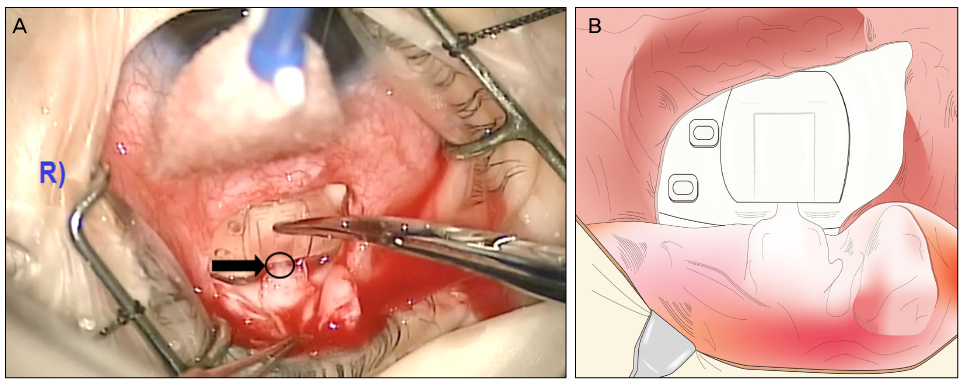J Korean Ophthalmol Soc.
2012 Jul;53(7):1053-1056. 10.3341/jkos.2012.53.7.1053.
Tissue Incarceration after Ahmed Valve Implantation
- Affiliations
-
- 1Department of Ophthalmology, Samsung Medical Center, Sungkyunkwan University School of Medicine, Seoul, Korea. ckee@skku.edu
- KMID: 2215872
- DOI: http://doi.org/10.3341/jkos.2012.53.7.1053
Abstract
- PURPOSE
To report cases of intraocular pressure that was normalized, after removing the capsule that had incarcerated into the valve after Ahmed valve implantation.
CASE SUMMARY
A 34-month-old boy visited our clinic for elevated intraocular pressure of the right eye. The patient had received Ahmed valve implantation 1 year earlier. At the first ophthalmological examination in our hospital, intraocular pressure of the right eye measured by Perkins tonometer was 28 mm Hg using Cosopt(R) and Iopidine(R), and 26 mm Hg after additional digital massage; the authors decided to remove the capsule with surgery. The fibrotic tissue was removed after finding the tissue incarcerated into the valve during the operation. One day after the surgery, without using any glaucoma medication, intraocular pressure of the right eye measured by Perkins tonometer was 15 mm Hg. Three months after surgery, using topical intraocular pressure lowering agents, intraocular pressure of the right eye was 18 mm Hg. Because the intraocular pressure of other patients after Ahmed valve implantation was not regulated well, surgery was performed, and the fibrotic tissue was removed after finding the tissue incarcerated in the valve during the operation.
Figure
Cited by 2 articles
-
Location of the Tube Tip in the Anterior Chamber and Change in Corneal Endothelium after Ahmed Valve Implantation
Won Hyuk Oh, Tae Woo Kim, Ki Ho Park, Dong Myung Kim
J Korean Ophthalmol Soc. 2013;54(3):469-474. doi: 10.3341/jkos.2013.54.3.469.Encapsulated Bleb Excision with Collagen Matrix Implantation Following Failed Ahmed Glaucoma Valve Implantation
Seong Eun Lee, Kyoung Nam Kim, Woo-Jin Kim, Sung Bok Lee, Chang-sik Kim
Korean J Ophthalmol. 2019;33(3):214-221. doi: 10.3341/kjo.2018.0110.
Reference
-
1. Lee YW, Yim JH, Lee SB, Kim CS. The factors associated with the success of Ahmed glaucoma valve implantation. J Korean Ophthalmol Soc. 2005. 46:1509–1517.2. Lai JS, Poon AS, Chua JK, et al. Efficacy and safety of the Ahmed glaucoma valve implant in Chinese eyes with complicated glaucoma. Br J Ophthalmol. 2000. 84:718–721.3. Morad Y, Donaldson CE, Kim YM, et al. The Ahmed drainage implant in the treatment of pediatric glaucoma. Am J Ophthalmol. 2003. 135:821–829.4. Lee JH, Kim SS, Hong YJ. A clinical study of the Ahmed valve implant in refractory glaucoma. J Korean Ophthalmol Soc. 2001. 42:1003–1010.5. Huang MC, Netland PA, Coleman AL, et al. Intermediate-term clinical experience with the Ahmed Glaucoma Valve implant. Am J Ophthalmol. 1999. 127:27–33.6. Hill RA, Pirouzian A, Liaw L. Pathophysiology of and prophylaxis against late ahmed glaucoma valve occlusion. Am J Ophthalmol. 2000. 129:608–612.7. Kim DH, Park CK, Ahn MD. Clinical results of Ahmed valve implantation in the aspects of complications. J Korean Ophthalmol Soc. 2003. 44:888–895.8. Trigler L, Proia AD, Freedman SF. Fibrovascular ingrowth as a cause of Ahmed glaucoma valve failure in children. Am J Ophthalmol. 2006. 141:388–389.
- Full Text Links
- Actions
-
Cited
- CITED
-
- Close
- Share
- Similar articles
-
- Encapsulated Bleb and Fibrous Ingrowth in the Ahmed Glaucoma Valve System and Bleb Revision with Mitomycin-C
- Change of Peripapillary Vessel Density after Ahmed Valve Implantation
- The Effect of Flat Anterior Chamber on the Success of Ahmed Valve Implantation
- Changes in Axial Length Following Trabeculectomy and Ahmed Glaucoma Valve Implantation
- Tube Erosion with Scleral Melting after Ahmed Valve Implantation Using a Synthetic Dural Substitute




